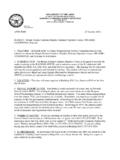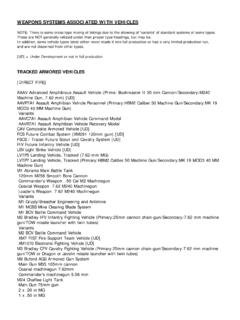Transcription of NAVAL FACILITIES ENGINEERING SERVICE CENTER
1 I NAVAL FACILITIES ENGINEERING SERVICE CENTER Port Hueneme, California 93043-4370 Technical ReportTR-2202-AMPby Billy Karrh MAR, Inc. Peter Tabor NAVAL FACILITIES ENGINEERING SERVICE CENTER March 2002 Approved for public release; distribution is unlimited. DEVELOPMENT OF A BOW MODULE FOR THE SEABOSS CAUSEWAY FERRY Final Report Printed on recycled paper ii This page left blank. iii REPORT DOCUMENTATION PAGE Form Approved OMB No. 0704-0811 The public reporting burden for this collection of information is estimated to average 1 hour per response, including the time for reviewing instructions, searching existing data sources, gathering and maintaining the data needed, and completing and reviewing the collection of information. Send comments regarding this burden estimate or any other aspect of this collection of information, including suggestions for reducing the burden to Department of Defense, Washington Headquarters services , Directorate for Information Operations and Reports (0704-0188), 1215 Jefferson Davis Highway, Suite 1204, Arlington, VA 22202-4302.
2 Respondents should be aware that notwithstanding any other provision of law, no person shall be subject to any penalty for failing to comply with a collection of information, it if does not display a currently valid OMB control number. PLEASE DO NOT RETURN YOUR FORM TO THE ABOVE ADDRESS. 1. REPORT DATE (DD-MM-YYYY) 2. REPORT TYPE 3. DATES COVERED (From To) March 2002 Final 4. TITLE AND SUBTITLE 5a. CONTRACT NUMBER 5b. GRANT NUMBER 5c. PROGRAM ELEMENT NUMBER DEVELOPMENT OF A BOW MODULE FOR THE SEABOSS CAUSEWAY FERRY 6. AUTHOR(S) 5d. PROJECT NUMBER 5e. TASK NUMBER 5f. WORK UNIT NUMBER Billy Karrh, MAR, Inc. Peter Tabor, NFESC 7. PERFORMING ORGANIZATION NAME(S) AND ADDRESSES 8. PERFORMING ORGANIZATION REPORT NUMBER Commanding Officer NAVAL FACILITIES ENGINEERING SERVICE CENTER 1100 23rd Avenue Port Hueneme, CA 93043-4370 TR-2202-AMP 9. SPONSORING/MONITORING AGENCY NAME(S) AND ADDRESS(ES) 10. SPONSOR/MONITORS ACRONYM(S) 11. SPONSOR/MONITOR S REPORT NUMBER(S) Commander NAVAL FACILITIES ENGINEERING CENTER 1322 Patterson Avenue, Suite 1000 Washington Navy Yard, DC 20374-5065 12.
3 DISTRIBUTION/AVAILABILITY STATEMENT Approved for public release; distribution is unlimited. 13. SUPPLEMENTARY NOTES 14. ABSTRACT This report describes the development of a bow module for the SEABOSS causeway ferry. A decision was made by the sponsor to develop a bow module that accommodates the majority of beaches where amphibious landings may occur and is practical to operate. This translated to a beach gradient of 1:50 or more. Flatter beach gradients may require a transition from the beach to deeper water by a pier-like facility, such as the floating causeway. The project effort included: a historical review of bow ramps for landing military vehicles on beaches; the development of design criteria for the bow module; the development of alternative concepts for the bow ramp and bow module; the evaluation and selection of a design concept for the bow module; and the preparation of detail design drawings for the bow module.
4 15. SUBJECT TERMS Causeway ferry, SEABOSS, amphibious landings, floating causeway, beach gradient, bow ramps 16. SECURITY CLASSIFICATION OF: 19a. NAME OF RESPONSIBLE PERSON a. REPORT b. ABSTRACT c. THIS PAGE 17. LIMITATION OF ABSTRACT 18. NUMBER OF PAGES 19b. TELEPHONE NUMBER (include area code) U U U UL 71 iv This page left blank. v EXECUTIVE SUMMARY The development of a beaching ramp capability for the SEABOSS causeway ferry (CF) bow module is reported. The SEABOSS bow module includes a bow thruster. SEABOSS is an advanced modular, floating causeway system that enables Logistics Over-the-Shore (JLOTS) operations to be executed in open-sea conditions through sea state 3 (SS 3). The SEABOSS beaching ramp is a key component of the self-powered causeway ferry. The primary mission of the SEABOSS CF is to discharge military vehicles from the CF to the beach.
5 This operation is part of the capability to offload vehicular cargo from Military Pre-positioned Force (MPF) ships and Roll-On/Roll-Off (RO/RO) ships. A historical review of vehicular beaching ramps for various types of vessels was conducted prior to the development of design concepts. Vehicular beaching ramps for the Navy s CFs have been used since the original Navy pontoon causeway system was developed during World War II. Beaching ramps for vessels of all types, including ships landing craft, and related applications were examined for both their good and bad features. Current users of the Navy s causeway system were consulted for their lessons learned from past operations. Design criteria were developed for the beaching ramp. The beach slope and the draft of the CF are the parameters that have the greatest effect on the design of the beaching ramp. Analytical reviews of the capability of beaching vessels to land on various beach slopes clearly indicated that landing vehicles on beaches flatter than 1:100 slope would require a ramp too long for practical use.
6 Therefore, the SEABOSS Project Management Office opted for a strategy to develop a beach ramp capability for beach slopes of 1:50 or steeper. This ramp would accommodate up to 75 percent of the beach gradients encountered in amphibious landings, as well as provide a ramp that is practical to stow, deploy, and use. Amphibious landing scenarios on flatter beaches will require the use of a transitional capability, such as the floating causeway moored to the beach. The SEABOSS bow module must interface with the landing ramp of the floating causeway. Having established the critical design criteria, concept alternatives were developed for the bow module. Alternatives were for the rake angle, the beach ramp, the deployment/retraction mechanism, and a backup deployment system. The design team judged the alternatives according to a set of evaluation criteria developed for that purpose. Four alternative concepts were selected for final evaluation by the team. The selected concept proposed a hinged ramp with hydraulic ram actuators to deploy and retract the ramp.
7 Hydraulic power to operate the rams is supplied by the diesel engine that drives the bow thruster. With the criteria and design concept established, the design details were executed by NFESC s design section. A complete set of drawings for the beaching ramp components of the bow module was provided. Detail drawings for the bow module structure and the bow thruster are to be developed by others. vi This page left blank. vii DEFINITIONS Approach Angle The supplement to the angle between an approach road and a sloping ramp. The approach angle refers to the maximum angle that a vehicle can negotiate with its front end as it moves forward onto a sloping ramp. Bow Ramp A hinged ramp structure that enables military vehicles to transition from the deck of the bow module to the beach or other designated floating structures. Breakover Angle Supplement to the angle between two ramps at different slopes.
8 Departure Angle Supplement to the angle between a departure ramp and the departure road . The departure angle refers to the maximum angle that a vehicle can negotiate with its rear end as it moves forward off of a sloping ramp. Dry Ramp A ramp sufficiently close to the beach to enable military vehicles to reach the shore without the requirement for a fording kit. Generally, no more than 18 inches still water depth at the foot of the ramp is considered a dry ramp. Gap Length Distance from the beach end of the beaching ramp to the waterline on the beach, when the CF is fully grounded for offload. Trafficability Ability to move vehicles over a particular area. ACRONYMS BM Bow module, a transition module with a floating hull structure and appurtenances, including the bow ramp, that enable the discharge/loading of military vehicles from/to the SEABOSS causeway ferry to the beach or to other designated floating structures.
9 CF Causeway ferry consisting of a powered module, intermediate modules, and a bow module. ELCAS(M) Modular Elevated Causeway FC Floating Causeway HET Heavy Equipment Trailer (US Army) viii MCS Modular Causeway System (US Army) MPF Military Pre-positioning Force RRDF Roll-On Roll-Off Discharge Facility RTCH Rough Terrain Container Handler ix Table of Contents Page Chapter 1 INTRODUCTION ..1 Chapter 2 BACKGROUND ..3 Chapter 3 HISTORICAL REVIEW OF BEACHING RAMPS ..5 BEACHING RAMPS FOR STEEP TO MODERATE BEACH GRADIENTS ..5 BEACHING RAMPS FOR MODERATE TO FLAT BEACH LESSONS LEARNED ..11 Chapter 4 DESIGN CRITERIA DEVELOPMENT ..15 OPERATIONAL REQUIREMENTS ..15 PERFORMANCE REQUIREMENTS ..16 FUNCTIONAL REQUIREMENTS.
10 21 SEABOSS BOW MODULE CRITERIA ..22 Chapter 5 CONCEPT ALTERNATIVES ..25 CONCEPTS FOR STEEP TO MODERATE BEACH ..25 CONCEPTS FOR MODERATE TO FLAT BEACH GRADIENTS ..31 Chapter 6 CONCEPT EVALUATION ..35 TRADE-OFF ANALYSES ..35 CONCEPT SELECTION ..41 Chapter 7 DESIGN EXECUTION ..43 Chapter 8 BIBLIOGRAPHY ..47 APPENDIXES A - CAUSEWAY FERRY MOMENTUM BEACHING ANALYSIS .. A-1 B - TRAFFICABILITY ANALYSIS ..B-1 C - CONCEPT SELECTION CRITERIA ..C-1 D - NFESC BOW RAMP DESIGN DRAWINGS .. D-1 E - SPECIFICATION FOR SEABOSS CF BOW RAMP MODULE ..E-1 x Table of Contents (continued) Page List of Figures Figure 3-1. Beaching ramps for steep to moderate beach gradients, past and present.












